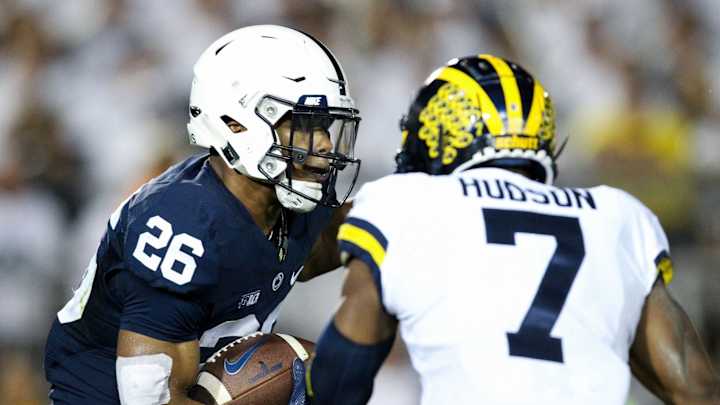Three Things To Watch In Today's Michigan Football Game

First-Quarter Do-Or-Die: The biggest reason Michigan is 1-6 on the road against ranked opponents - the Wolverines start games horribly.
In those six losses, the Maize and Blue were outscored 56-3 in the first quarter, trailing after 15 minutes in five of those six games (Ohio State 2016, when it was 0-0 after one period of play, is the lone exception).
In the second, third and fourth quarters (and overtime) of those six defeats, Michigan was outscored 161-117. Still not good, but close enough that had the Wolverines not fallen behind so badly, so consistently, they probably could have rallied for a victory or two.
Michigan didn't lead rival Michigan State after the first quarter when the two played in East Lansing in 2018 - it was 0-0 - but U-M did hold a first-half lead (7-0).
The Maize and Blue held a first-half lead against Ohio State in 2016 too. That game went to double overtime, with OSU prevailing 30-27; Michigan beat the Spartans in regulation 21-7.
In both contests, Michigan finished the opening quarter tied, and the key tonight is for the Wolverines to survive the first 15 minutes within striking distance. That didn't happen the last time U-M played in State College, falling behind 14-0 after one in an eventual 42-13 loss to the Nittany Lions. It didn't happen earlier this season in Madison, trailing 14-0 after the first quarter and losing 35-14.
Comfort In The Pocket: One of the nation's steadiest signal-callers in the first four weeks of the season - he had not thrown an interception and had completed 66.1 percent of his 118 pass attempts - Nate Stanley found himself under constant duress the past two games against Michigan and Penn State.
The results? He completed 54.8 and 58.1 percent of his passes, was picked off four times, and posted pass efficiency ratings of 92.47 and 117.04 in a pair of Hawkeye losses.
No matter how experienced, stout or accurate a quarterback is, when he's pressured, generally his production dips. Penn State's Sean Clifford, for example, hasn't faced much heat, but when the Hawkeyes got in his face … he posted season lows in completions (12), completion percentage (50.0), yards (117), yards per attempt (4.9) and passer rating (104.7) Oct. 12.
Penn State and Michigan are two of the top defenses in college football bringing down the quarterback, the Nittany Lions ranking second nationally with 27 sacks and U-M 13th with 21. They both feature ferocious defensive ends (Yetur Gross-Matos and Shaka Toney for PSU, Aidan Hutchinson and Kwity Paye for Michigan).
But what could really impact both QBs is the pressure from the interior of the defensive line, Penn State featuring graduate-senior Robert Windsor and the Wolverines featuring senior Michael Dwumfour.
Windsor had Stanley uncomfortable and flustered, and it showed.
Dwumfour returned in Week 4 against Rutgers (after sitting out the first three games with an injury) and immediately caused chaos for the Scarlet Knights, and then the Hawkeyes and Illini.
While we debate which quarterback will step up for his team and prove to be the biggest positive difference-maker, the real question is: which one will be comfortable in the pocket? Neither Clifford nor Michigan's Shea Patterson has demonstrated an ability to rise above when things don't go their way.
It's unlikely either of them will have it easy tonight but are they just a little out of sorts or completely uncomfortable in the pocket?
Running Still Matters: One of the oldest, most-cliched statements is that whichever team wins the rushing battle has the best chance to win the game. And while today's college football is much more pass-happy, running success has been one of the determining factors in this rivalry over the years, certainly the last four seasons between Jim Harbaugh and James Franklin.
In fact, the winner of the ground battle in 2015 (Michigan 87-70), 2016 (U-M 326-70), 2017 (Penn State 224-103) and 2018 (Michigan 259-68) has proven victorious on the scoreboard too. Will that trend continue tonight?
After struggling to establish the run in their first five games, averaging 128.4 yards per contest, the Wolverines broke out with 295 yards and 6.2 yards per carry at Illinois in Week 6.
Against four Power 5 conference opponents, Penn State has averaged 184.5 yards rushing per game, including 177 at Iowa last week. The Nittany Lions have won the ground-game battle in each of their six wins, and there is no doubt the ability to move the chains running the football has greatly aided Clifford.
The running game was Patterson's best friend a week ago too, and for an offense that still hasn't found its rhythm in the passing attack - Michigan ranks seventh in the Big Ten in yards per game (231.2) and pass efficiency rating (133.98) -- the potential for rushing proficiency could be the difference between another road loss against a ranked opponent and a narrative busted.
